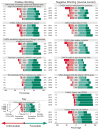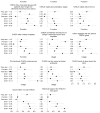A six-year repeated evaluation of computerized clinical decision support system user acceptability
- PMID: 29500025
- PMCID: PMC5836810
- DOI: 10.1016/j.ijmedinf.2018.01.011
A six-year repeated evaluation of computerized clinical decision support system user acceptability
Abstract
Objective: Long-term acceptability among computerized clinical decision support system (CDSS) users in pediatrics is unknown. We examine user acceptance patterns over six years of our continuous computerized CDSS integration and updates.
Materials and methods: Users of Child Health Improvement through Computer Automation (CHICA), a CDSS integrated into clinical workflows and used in several urban pediatric community clinics, completed annual surveys including 11 questions covering user acceptability. We compared responses across years within a single healthcare system and between two healthcare systems. We used logistic regression to assess the odds of a favorable response to each question by survey year, clinic role, part-time status, and frequency of CHICA use.
Results: Data came from 380 completed surveys between 2011 and 2016. Responses were significantly more favorable for all but one measure by 2016 (OR range 2.90-12.17, all p < 0.01). Increasing system maturity was associated with improved perceived function of CHICA (OR range 4.24-7.58, p < 0.03). User familiarity was positively associated with perceived CDSS function (OR range 3.44-8.17, p < 0.05) and usability (OR range 9.71-15.89, p < 0.01) opinions.
Conclusion: We present a long-term, repeated follow-up of user acceptability of a CDSS. Favorable opinions of the CDSS were more likely in frequent users, physicians and advanced practitioners, and full-time workers. CHICA acceptability increased as it matured and users become more familiar with it. System quality improvement, user support, and patience are important in achieving wide-ranging, sustainable acceptance of CDSS.
Keywords: Computerized decision support system; Decision support; Quality improvement; User acceptability; User satisfaction.
Copyright © 2018 Elsevier B.V. All rights reserved.
Conflict of interest statement
Drs. Carroll and Downs are co-creators of CHICA. CHICA was developed at Indiana University, a non-profit organization. In 2016, one of the authors (SD) co-founded a company to disseminate the CHICA technology. There is no patent, and at this time, there is no licensing agreement. All data presented were collected by an investigative team separate from the authors and developers, and collection occurred prior to the creation of the aforementioned company. The data were analyzed by the first author (RG), who has no conflict of interest. The other authors have indicated they have no potential conflicts of interest to disclose.
Figures




Similar articles
-
Understanding the acceptability of a computer decision support system in pediatric primary care.J Am Med Inform Assoc. 2014 Jan-Feb;21(1):146-53. doi: 10.1136/amiajnl-2013-001851. Epub 2013 Jun 20. J Am Med Inform Assoc. 2014. PMID: 23788628 Free PMC article.
-
Leveraging electronic tablets for general pediatric care: a pilot study.Appl Clin Inform. 2015 Jan 7;6(1):1-15. doi: 10.4338/ACI-2014-09-RA-0071. eCollection 2015. Appl Clin Inform. 2015. PMID: 25848409 Free PMC article.
-
Experience with decision support system and comfort with topic predict clinicians' responses to alerts and reminders.J Am Med Inform Assoc. 2016 Apr;23(e1):e125-30. doi: 10.1093/jamia/ocv148. Epub 2015 Nov 13. J Am Med Inform Assoc. 2016. PMID: 26567326 Free PMC article.
-
Optimizing Clinical Decision Support System Functionality by Leveraging Specific Human-Computer Interaction Elements: Insights From a Systematic Review.JMIR Hum Factors. 2025 May 6;12:e69333. doi: 10.2196/69333. JMIR Hum Factors. 2025. PMID: 40327851 Free PMC article. Review.
-
Reasons For Physicians Not Adopting Clinical Decision Support Systems: Critical Analysis.JMIR Med Inform. 2018 Apr 18;6(2):e24. doi: 10.2196/medinform.8912. JMIR Med Inform. 2018. PMID: 29669706 Free PMC article. Review.
Cited by
-
Evaluation Framework for Successful Artificial Intelligence-Enabled Clinical Decision Support Systems: Mixed Methods Study.J Med Internet Res. 2021 Jun 2;23(6):e25929. doi: 10.2196/25929. J Med Internet Res. 2021. PMID: 34076581 Free PMC article.
-
Designing a reference architecture for health information systems.BMC Med Inform Decis Mak. 2021 Jul 8;21(1):210. doi: 10.1186/s12911-021-01570-2. BMC Med Inform Decis Mak. 2021. PMID: 34238281 Free PMC article.
-
Exploring the role of professional identity in the implementation of clinical decision support systems-a narrative review.Implement Sci. 2024 Feb 12;19(1):11. doi: 10.1186/s13012-024-01339-x. Implement Sci. 2024. PMID: 38347525 Free PMC article.
-
Improving Patient-Centered Communication about Sudden Unexpected Death in Epilepsy through Computerized Clinical Decision Support.Appl Clin Inform. 2021 Jan;12(1):90-99. doi: 10.1055/s-0040-1722221. Epub 2021 Feb 17. Appl Clin Inform. 2021. PMID: 33598905 Free PMC article.
-
Cardiologist perceptions on automated alerts and messages to improve heart failure care.Am Heart J. 2025 Jan;279:59-65. doi: 10.1016/j.ahj.2024.10.007. Epub 2024 Oct 16. Am Heart J. 2025. PMID: 39423991
References
-
- Bright TJ, Wong A, Dhurjati R, et al. Effect of clinical decision-support systems: a systematic review. Ann Intern Med. 2012;157:29–43. - PubMed
Publication types
MeSH terms
Grants and funding
LinkOut - more resources
Full Text Sources
Other Literature Sources

